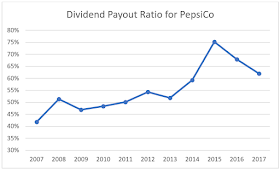PepsiCo, Inc. (PEP) manufactures, markets, and sells various foods, snacks, and carbonated and non-carbonated beverages worldwide. The company operates in four divisions: PepsiCo Americas Foods (PAF), PepsiCo Americas Beverages (PAB), PepsiCo Europe, and PepsiCo Asia, Middle East and Africa (AMEA). The company is a dividend champion, which has increased distributions for 46 years in a row.
Between 2007 and 2017, PepsiCo managed to grow its earnings from $3.41/share to $5.11/share. The 2017 figures include a $2.5 billion provisional net tax expense ($1.73 per share) as a result of the U.S. Tax Cuts and Jobs Act (TCJ Act) passed on December 22, 2017. PepsiCo is expected to earn $5.66 per share in 2018 and $5.96 per share in 2019.
Share buybacks have resulted in the decrease in outstanding shares from 1.645 billion in 2007 to 1.44 billion in 2017. A history of consistent share repurchases is helpful, because it shows that the company is willing to help out long-term holders of stock with increased proportional share of earnings and the business over time.
PepsiCo has a wide moat, due to strong recognizable brands it owns, scale of operations, relationships with retailers and having a distribution network of bottlers that will take billions of dollars to create and replicate. Because of the consumer affinity for branded snacks and beverages that PepsiCo makes, they are less likely to switch to a cheaper product. Hence, PepsiCo is part of a sort of unregulated monopoly, which also has some pricing power.
The company has a solid distribution network, a portfolio of strong brand names, and solid relationships with retailers. This portfolio also includes 22 brands with sales of at least $1 billion for each brand. The market dominance in the snack business of Frito-Lay has resulted in higher margins, relative to competitors.
Frito-Lay generates a quarter of revenues, but close to 45% of profits. PepsiCo beverages accounts for a third of revenues and a quarter of profits while PepsiCo International account for 38% of revenues and also a quarter of profits. The rest is generated by Quaker Foods.
Future growth in earnings will come from international expansion, particularly in emerging markets. The number of servings that consumers abroad consume is much lower than that in North America, which is why I believe there will be years of growth ahead. In addition, I like the fact that the company sells not only beverages, but snacks as well. As an investor, I like to be diversified; hence, I like it when the companies I own are diversified in products and geography. It is estimated that the company achieves significant synergies by operating both a beverage and a snack business.
Earnings can also increase through organic growth for those snacks and beverages, and price increases to offset cost pressures. Strategic cost initiatives to streamline operations, increase productivity and reduce redundancies are another tool to increase shareholder earnings. The distribution networks of the bottlers acquired could be used to push some of PepsiCo's non-beverage products such as snacks and other foods.
Sales of carbonated drinks have been softening, due to increased health awareness by consumers in developed markets. However, PepsiCo has also focused on fast growing non-carbonated soft drinks. The company's innovation in the area has been successful with the introduction of Aquafina, Gatorade and Propel, Lipton teas and Tropicana.
Earnings growth could also come from other strategic acquisitions, as well as product innovations in health and wellness food and beverage section. For example PepsiCo recently completed the acquisition of SodaStream International, bringing in-home carbonated beverages to consumers. This move lets PepsiCo expand its diverse options on to another platform.
The annual dividend payment has increased at a rate of 8.90% per year over the past decade, which is higher than the growth in EPS.
A 9% growth in distributions translates into the dividend payment doubling every eight years on average. If we check the dividend history, going as far back as 1973, we could see that PepsiCo has actually managed to double dividends every six years on average. I would expect future dividend growth to be closer to 5% - 6%/year over the next decade.
In the past decade, the dividend payout ratio increased from 42% in 2007 to a little over 62% in 2017. I generally do not want to see high dividend growth because of expansion in the payout ratio. If we look at forward earnings of $5.66/share, the payout is at 65%, which is still high. A lower payout is always a plus, since it leaves room for consistent dividend growth minimizing the impact of short-term fluctuations in earnings.
Currently, the company is fairly valued at 19.60 times forward earnings and yields 3.40%. It is slightly cheaper than Coca-Cola, which sells for 22.90 times forward earnings and has a current yield of 3.30%.
Relevant Articles:
- How to value dividend stocks
- Successful Dividend Investing Requires Patience
- Dividend Companies Showering Shareholders With More Cash
- Rising Earnings – The Source of Future Dividend Growth



